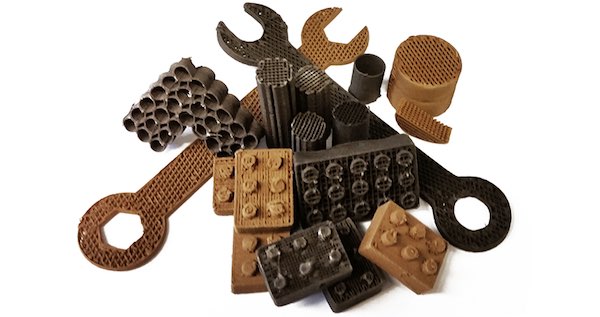
[Image above] Tools and building blocks 3-D-printed with lunar and Martian dust. Credit: Northwestern University
Good news for those of you who agree with Elon Musk’s plans to go to Mars: Earth and Mars may not be so different after all.
NASA recently reported that, like Earth, Mars has metal in its atmosphere—scientists detected iron, magnesium, and sodium ions in the upper Martian atmosphere. According to a Popular Mechanics story, “This is the first detection of metal ions in the ionosphere of any planet other than Earth.”
Which makes colonization of the red planet, a la The Martian, seem even more feasible in the near future.
But to colonize other planets, humans need to be able to live off those distant lands, producing the goods and products needed for survival from materials available on site.
Because it’s just not feasible to haul everything needed to survive on the red planet some 225 million kilometers across space.
Other groups have already reported success in molding Martian soil into concrete.
But now, researchers at Northwestern University have come up with a more flexible solution—they devised a technique to 3-D print soft rubber-like materials out of ink composed primarily of extraterrestrial soil. Using a biologically derived binder to hold the soil particles together, the team demonstrated that their unique method can 3-D print biodegradable tools, building blocks, and other structures.
“For places like other planets and moons, where resources are limited, people would need to use what is available on that planet in order to live,” Ramille Shah, assistant professor of materials science and engineering at Northwestern’s McCormick School of Engineering, says in a Northwestern press release. “Our 3-D paints really open up the ability to print different functional or structural objects to make habitats beyond Earth.”

Credit: NASA Johnson; Flickr CC BY-NC 2.0
Shah and researchers at Northwestern’s Tissue Engineering and Additive Manufacturing Lab had previously devised the 3-D ink printing method, called 3-D painting, that they’ve applied to completely different materials, including a 3-D-printed bioceramic composite the could help repair bones.
Applying the same technology to a different medium, the team’s recent work—partially supported by a gift from Google, according to the press release—optimized the same printing process using NASA-approved samples of lunar and Martian soil.
Those soil samples—comprised primarily of silicates, aluminates, and iron oxides—“are unrefined, highly compositionally and morphologically inhomogeneous natural, volcanic materials that emulate the surface environments of specific regions on the Moon and Mars, respectively,” according to the open-access paper describing the work.
To bind the soil particles together, the researchers mixed in a biodegradable polymer to create a 3-D printer ink. The biopolymer, polylactic-co-glycolic acid (PLGA), can be made from biological, renewable resources, which is critical for its supply on foreign planetary bodies. In the paper, the authors note that humans colonizing Mars could source monomers for PLGA from readily available biological materials—compost and urine.
Using the ink, the Northwestern team optimized extrusion through a 3-D printer nozzle, demonstrating the ability to additively manufacture a cache of versatile structures that would be useful when it comes to colonizing Mars, including wrenches, cylinders, and LEGO-like building blocks.
Structures 3-D-printed with the team’s Martian soil–biopolymer ink are 90% by weight extraterrestrial powder and 10% biopolymer, creating a soft material that is flexible and elastic, yet tough.
“The material can be cut, rolled, folded, and otherwise shaped after being 3-D painted, if desired,” according to the press release.
And while soft and flexible structures would be preferable for some applications, other uses might require hard and stiff structures. Take that 3-D-printed wrench, for example—a soft and flexible wrench isn’t going to be much help tightening bolts.
So the researchers’ next step is to optimize ways to harden the 3-D-printed structures by firing them in a furnace, converting the soft rubber-like materials into hard ceramic-like structures.
If they are successful, this work could be a really big leap for mankind when it comes to living in the vast arena beyond our pale blue dot.
But, you may not want to book your one-way ticket to Mars just yet—there are still challenges to space travel, the remaining of which may be the most difficult to solve.
The open-access paper, published in Scientific Reports, is “Robust and elastic lunar and Martian structures from 3D-printed regolith inks” (DOI: 10.1038/srep44931).
Author
April Gocha
CTT Categories
- Aeronautics & Space
- Construction
- Manufacturing
- Material Innovations
- Weekly Column: “Other materials”
Related Posts
Other materials stories that may be of interest for January 14, 2026
January 14, 2026

